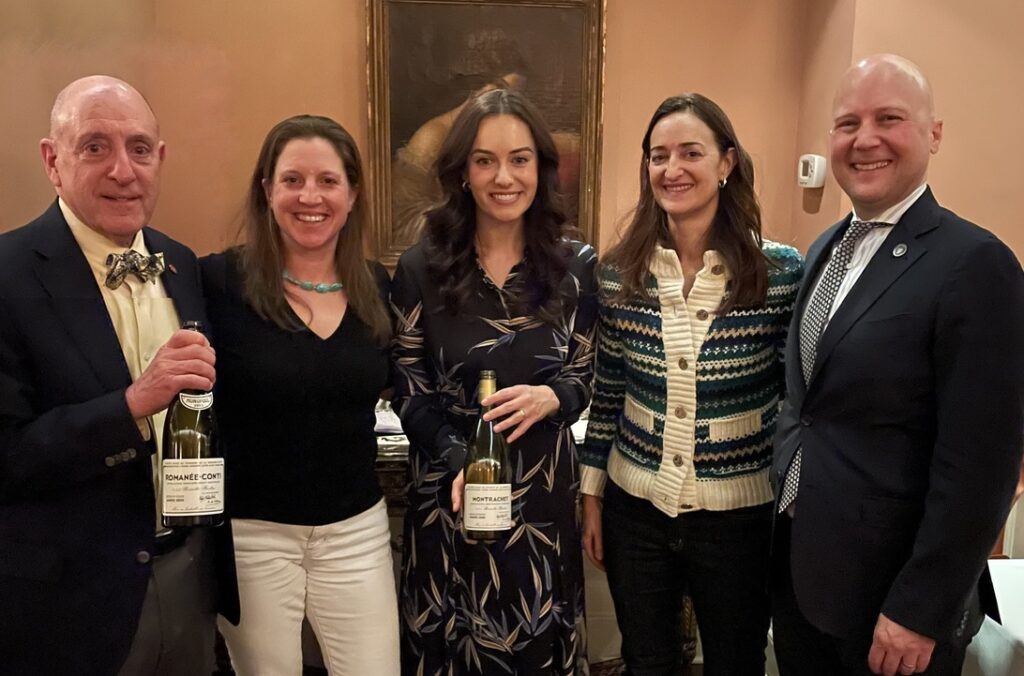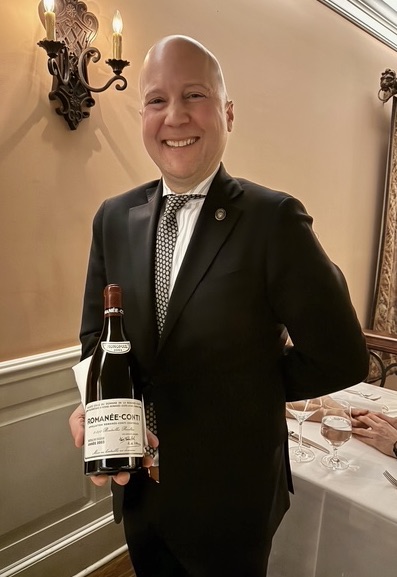Would you drink or sell a $20,000 bottle of wine?
By Jerry Kolins, MD, DipWSET, Certified Sommelier
Almost 20 years ago, once a year, for a few years in a row, I purchased six-bottle cases of wine from the Domaine de la Romanée-Conti through my wine merchant at Vintage Wines, San Diego, CA. Each case cost about $3500 and consisted of 6 red Burgundy wines from the most famous vineyards owned by the producer. Regardless of the vineyard, each wine was made from the Pinot Noir grape. I also purchased one bottle of the 2000 Montrachet from this same Domaine de la Romanée-Conti, often simply referred to as DRC. That Chardonnay is valued at $6,680 by wine-searcher.com today.
At the time I purchased this treasure, I received a wooden box secured with a metal wire band within which were the 6 bottles. Only one bottle was the 2003 DRC. That is the bottle worth $20,000 today. However, there were also two bottles of 2003 La Tâche, which Wine-Searcher.com values at $6120 each. The remaining three came from one of the producer’s other vineyards, i.e., Echezeaux, Romanée-Saint-Vivant, Richebourg or Grands Echezeaux vineyards.
These bottles have been resting at 57°F ever since, just waiting for me to decide what to do with them. A few years ago, while dining at George’s at the Cove Restaurant in La Jolla, CA, a gentleman who sat at a table adjacent to mine overheard me saying I had this DRC as well as the 2002 vintage. He leaned over toward my table and offered, “I will give you $20,000 in cash for those two bottles.” I took his phone number and called my close friend.
“Arthur, should I take the $20,000 in cash?” Art said, “It is time you asked yourself the key question: What is the one thing you have denied yourself that will no longer be denied after you receive $20,000 from the sale of the wines?” I replied, “I really haven’t denied myself anything.” He then said to me, “You have answered your own question. You need to open that bottle and learn why people will pay that much for wine.” Arthur went on to say, “When you open it, you should invite me over for dinner.” I did, but we opened the La Tâche.
The $20,000 2003 DRC bottle was opened at Elizabeth’s Restaurant on L Street in Washington, DC to be consumed with my mentors who had encouraged my studies through both the Wine and Spirit Educational Trust (WSET) and the sommelier certification tract. A total of 4 instructors tasted this wine and offered their insights as to why these wines are among the most expensive in the world. Elizabeth’s is perfect for this experience in that it is a vegan restaurant. If you are tasting Montrachet and Domaine de la Romanée-Conti, pairing with beef is sinful. This was the perfect setting for high-end Chardonnay and Pinot Noir.
If you are new to wine study, here is a CliffsNotes history of wine education and certification: The WSET, founded and headquartered in London, began educating and certifying students in 1969. Last year WSET had over 100,000 students worldwide. WSET offers a diploma permitting the post-nominal DipWSET. These folks are wine experts without a focus on marketing and selling. That inspired the Court of Master Sommeliers (CMS), a group born within WSET, to separate due to a difference in mission. In summary, both groups, WSET and CMS, consist of wine experts, but sommeliers specialize in service and marketing like no other.
A member of the Board of Directors of the Court of Master Sommeliers-America, Robert Jones, MS, told me that the sommelier is responsible for everything placed on a restaurant table except that which is prepared by the chef. So, we are not just talking about wine. We include beer, cocktails, sake, and distilled spirits of all kinds. For example, I learned from Sommelier Mike Markarian of Italy’s contribution to creativity when I tasted Amaro Nonino. This amaro, made in Friuli from distilled freshly crushed grapes, skins, seeds, and stems (grape must), is part of a potion that includes dozens, if not hundreds, of additional secret ingredients like herbs, flowers, and tincture of magic.
Our four tasters at Elizabeth’s were Kasia White, DipWSET, Claudia Chamberlain, DipWSET, AS (Advanced Sommelier); Caroline Hermann, Master of Wine (MW); and Mike Markarian, AS.

From left to right: Jerry Kolins, Kasia White, Claudia Chamberlain, Caroline Hermann, and Mike Markarian
Kasia has a way with wine and words. She describes the Montrachet as “shockingly vibrant, both in color and on the palate. Nose is full of caramel, brown butter, honeycomb and marzipan. Palate is brighter with fresh lemon zest, lemon curd, dry, hard caramel (like Werther’s Original caramel hard candies!) and is tertiary focused. Extremely well-balanced with a long finish.” I had to google Werther’s Original. One cannot excel in wine tasting descriptions without extensive fruit, vegetable, and confectionary encounters.
Kasia goes on to note the following after tasting the DRC: “Nose lush with moss, wet leaves, prune and dried black currant, fresh thyme, mint, violets, dried rose petals and tar. Palate rushes forward with appropriately ripe red fruit: red currant, cranberry and then is followed by subtle clove, delicate firewood ash, black tea. Texture is rich, and silky smooth with fine grained tannins. At once opulent, and still somehow dainty and feminine. Extremely well integrated, well balanced, and a long finish.”
Our Master of Wine, Caroline Hermann, describes the 2000 Montrachet: “pale topaz hue, lifted acidity, precise, focused body, evolving long length. Caramelized shallots, wet stone minerality, rich yet lifted. Smoke, chalk, cheese rinds, umami, roasted cashew. The 2003 DRC – “round harmonized tannin, not noticeably lifted but perfectly balanced, perfumed, biblical spice, lithe, violet perfume, not a whiff of dried fruit, remarkable for the vintage, streak of red cherry Kirsh and framboise, silky velvety, evolving to roses and bergamot.” I didn’t know bergamot, so I had to look it up. Webster’s says it is a pear-shaped citrus fruit with a yellow to green rind yielding a bitter, fragrant essential oil considered a hybrid of sour orange and a lemon. Caroline uses the term “biblical spice” to trigger thoughts of sandalwood, frankincense and myrrh.
Claudia Chamberlain, DipWSET, AS, concludes: “The 2000 Montrachet presents a stunning color of spun gold, nearly honey-hued. On the nose, it is lifted and elegant, with an ethereal yet concentrated profile. Extremely nuanced with layers of toasted nuts, lemon meringue, buttercream icing, marzipan, and delicate white florals are interwoven with a precise minerality component of oyster shell and crushed chalk. There is a decidedly umami character, with notes of aged parmesan and cream of mushroom. On the palate, it is both round and focused, delivering crystalline acidity and decadent creaminess. Mouthwateringly savory and delicious, the wine feels remarkably youthful, showing the energy and finesse of something much younger than 25 years.”
Then Claudia continues with the DRC: “The 2003 Romanée Conti is medium ruby – revealing none of its 20+ year age away on sight and giving way to a wine that combines richness with structure. High-toned and opulent, it unfurls with nearly kaleidoscopic development – aromas of exotic spices and dried rose petals give way to a darker fruit core of kirsch and Chambord. Distinctly savory with sage, bay leaf, and earthy undertones, adding layers of complexity. The palate is plush yet precise, with suede-like moderate tannins and mouthcoating acidity that combine to give the wine a silky mouthfeel. It is seamlessly integrated and refined, showcasing no baked or oxidative quality on nose or palate, rendering it utterly remarkable for the vintage.”
The above tasting notes lead me to conclude that communication with wine specialists is best supported with very high verbal SAT scores. I did better in math.
You have got to be asking, “Was that experience worth $20,000?” Have you seen Pierce Brosnan in The Thomas Crown Affair (1999)? He bets $100,000 on a golf swing and says, “It is a beautiful Saturday morning, John. What the hell else are we going to do?” I cannot relate to Thomas Crown. But, if you haven’t denied yourself and you are smitten by wine, the curiosity is too great to pass up. All I needed was a few educated, passionate wine lovers to tell me what it all means. That was worth the price of admission. And, at no extra charge, I enjoyed the pleasure of witnessing 4 wine experts reach nirvana. For me, that was heaven.

Mike Markarian, Advanced Sommelier for Elizabeth’s Restaurant in Washington, DC, serves the $20,000 bottle of Romanée-Conti.
Leave a Reply